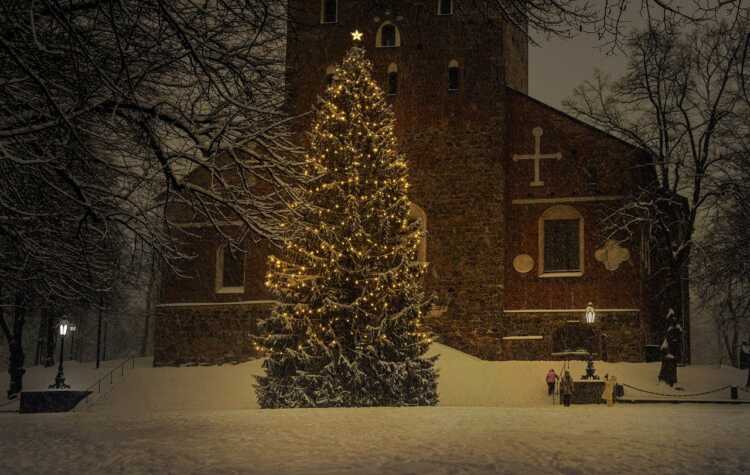Are Christmas Trees Pegan?
We’re all familiar with Christmas trees, one of the most standout features of the festive period. There’s nothing better than coming down the stairs on Christmas morning and seeing all the presents sitting under the tree. There’s just something about Christmas trees that captures the imagination — not for nothing are they featured in cities across the world, shining like a beacon during December and into January.
 As with most things in life, the more you dive into the history of Christmas trees, the more interesting they become. While you’ll have memories of the trees of your childhood and more closely associate them with your household during the holidays, there’s actually a pretty rich history regarding Christmas trees. They’ve been used by humans for thousands of years! Of course, it’s fair to say that Christmas trees in the olden days were probably not quite as we see them today. For starters, they didn’t have fairy lights to hang since they hadn’t been invented yet!
As with most things in life, the more you dive into the history of Christmas trees, the more interesting they become. While you’ll have memories of the trees of your childhood and more closely associate them with your household during the holidays, there’s actually a pretty rich history regarding Christmas trees. They’ve been used by humans for thousands of years! Of course, it’s fair to say that Christmas trees in the olden days were probably not quite as we see them today. For starters, they didn’t have fairy lights to hang since they hadn’t been invented yet!
In this blog, we’re going to run through some history regarding Christmas trees and answer a question that has caused plenty of confusion among people in years gone by: are Christmas trees pagan? As with all other things that have a long history, we can’t say that anyone knows for sure about the Christmas trees, but the information that we outline below is the most credible information!
Once you’ve finished reading the article, you might just look at your Christmas tree differently next year. After all, this isn’t just a tradition that dates back a few decades: it links the people celebrating the festive period today with people who had their own celebrations many thousands of years ago!
The History of Christmas Trees
So let’s dive right into the matter of paganism. Is there a connection between pagans and the Christmas tree? The answer is that yes, there is! It all dates back to the pre-Christianity age when people in certain countries would decorate their properties with trees. It’s usually only when we take one step back and think about the process of putting a tree inside our homes that we understand how strange it is!
The people in the northern hemisphere of Europe used to use trees to decorate their properties around the winter solstice, which, if you didn’t know, is on December 21. It’s got a lot of significance for people that follow the earth’s natural rhythms, since from the day forward, the days begin to get longer each day (and by that, we mean the sun sets a little later each day).
If you were living in the north of Europe, then your days could be very short — in fact, if you go far enough north, then the sun doesn’t set at all around this period. And it should probably go without saying that this can be a little bleak. Though you can normally see the Northern Lights dancing during the darkest days of the year, even they can be a little boring — what you really want to see is the sun. The problem that people in northern Europe had was that the sun had been gone for so long that they could easily forget that it’d never return!
So they needed a bit of a reminder. Unlike most trees, evergreen trees don’t lose their leaves during the colder months — and for this reason, they can serve as a useful reminder that life still exists. When people would see the tree at their home, they would know that the sun has only gone temporarily, and that summer will surely return! Plus, the other benefit of putting trees inside the home was that it brought a little bit of colour into an environment that was looking a little uninspiring.
Other Tree Celebrations
While that above story was about people in the northern reaches of Europe, they’re not the only ones who have used Christmas trees — or something like them — in the past. If you were in Egypt thousands of years ago, then you might find people decorating their homes with green palm rushes. They’d do this to celebrate Ra, one of their gods.
You would also find people using trees to decorate their home in Ancient Rome too. In fact, just like Christmas, this process was linked to one specific event: Saturnalia. This is one of the more interesting tidbits of Roman life, which makes you glad that you live in today’s age, rather than back then.
This festival took place around the same time as what would later become Christmas, running for a week from December 17 – 25. The festival was famous because it was “lawless.” That means that during that time, there wasn’t anything that was considered to be illegal anymore. You could pretty much do what you want without fear that the law would catch up with you. While that is something that should rightly be feared, in reality, most people don’t want to commit crimes — they want to play nice! And that’s just what happened during the festival, with many people using it as an opportunity to exchange presents and all-around do good deeds.
On the doors, in their homes, and in the temples of Rome, people would hang evergreen boughs in much the same way that we do today. Also, the date of the festival and its connection to Christmas is not by accident — in fact, it’s entirely possible that we celebrate Christmas Day because of the festival.
When Christianity was just taking off, Romans tried to integrate their religion with the historically pagan festival. They didn’t necessarily pick that date because Jesus was born then (they think he was born many months later), but because there was already the framework of celebration.
Moving Into the Modern World
OK, so that’s all ancient history, so how did we get to the point where we’re all rushing out to get Christmas trees each year? The history of the modern Christmas tree isn’t quite as old, but it’s still pretty old — it dates back to around the 16th century in Germany.
It was during this period that trees began to get their Christian connection. Back in the late middle-ages in Germany, a common pastime was to attend big performances that would take place outdoors. These places would be biblically related, for instance, they would recreate the story of the Garden of Eden. It’s not always easy to recreate the Garden of Eden when you’re in the middle of Germany, so you have to get creative. In order to symbolise the Garden of Eden, the people hosting the performance would hang fruit from a big evergreen tree. And you can probably see where we’re going with this: they think that this is the reason why we now hang ornaments on our trees.
From then on, the Christmas tree continued to grow in popularity, and more traditions developed with them. Martin Luther was apparently the first person to put a candle — to represent a star — on top of a Christmas tree. So the next time you’re climbing up on a ladder to put a star on top of your tree, you have him to thank.
Even though those stories were the precursor for the trees we have today, there’s still a big jump between that experience and what we know today. The modern trend dates back to 1846 and is connected to the Queen of England. She was sketched (since photographs weren’t a thing back then) standing around a festive Christmas tree with her German husband. Let’s remember that Christmas trees developed in Germany — if it wasn’t for Germans, we might not have any Christmas trees at all.
And we also have to thank Queen Victoria. She was very popular with the people of Britain, so when they saw that she was celebrating Christmas with an indoor tree, they decided it would be a good idea to do the same! Things took a little longer to reach North America, who weren’t as in love with Queen Victoria as the Brits. It was the writers of the time that brought Christmas to the masses, particularly stories like Twas the Night Before Christmas, which created a magical Christmas scene — with a tree included — and also set the groundwork for the modern incarnation of Santa Claus, who was also in the story.
And Today?
And so where are we today with Christmas trees? They seem to be going stronger than ever before, and really, can you ever envision a time when you won’t go out to buy a tree when December rolls around? These days, Christmas trees have become an art form, with people going to great lengths to decorate them in a way that honours the season yet still has them looking great. You can even buy fake trees, though in our opinion, it’s much better to get the real thing. After all, people have been using real trees to decorate their homes for thousands of years, and it’s good enough for them, then it’s good enough for us.






